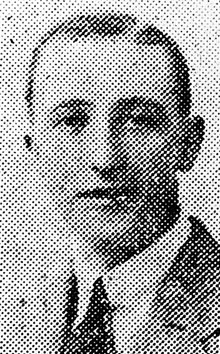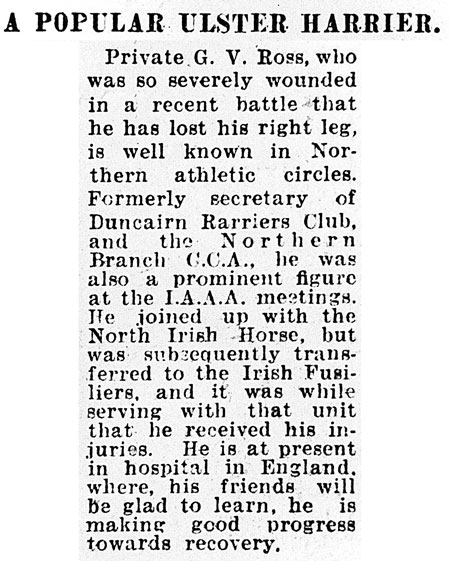Private George Victor Ross

George Victor Ross was born on 9 March 1887 in Glasgow, the fourth or fifth of eight children of publican (later spirit merchant and commission agent) Finlay Ross and his wife Marion (née Thompson). The family moved to Belfast soon after George's birth. By the time of the 1911 Census he was living in Clanchattan Street, Belfast, with his widowed mother and three of his siblings and working as a commercial traveller in canned meats.
Ross enlisted in the North Irish Horse on 12 December 1916 (No.2323). He trained at the regiment's Antrim reserve camp before embarking for France in the first half of 1917, where he was posted to one of the squadrons of the 1st or 2nd North Irish Horse Regiments.
In August-September 1917 the 2nd NIH Regiment was disbanded and its men, together with some surplus to the needs of the 1st NIH Regiment, were transferred to the Royal Irish Fusiliers, an infantry regiment. Most, including Ross, were transferred on 20 September and posted to the 9th (Service) Battalion – renamed the 9th (North Irish Horse) Battalion – joining it in the field at Ruyaulcourt five days later. Ross was issued regimental number 41330.
Ross was severely wounded during the Battle of Cambrai, probably in the fighting for the village of Moeuvres on 22 and 23 November 1917, resulting in the amputation of his right leg. Following treatment in hospitals through 1918 and 1919, on 29 November 1919 he was discharged, being 'no longer physically fit for military service' (paragraph 392 (xvi), King's Regulations).
At some point after the war Ross moved to England. At the time of the 1939 Register he was living with his wife Annie and their children at 25 King's Lane, Leeds, and working as a commercial traveller in foodstuffs.

At least three of Ross's brothers also served in the war – Adam Ross in the Royal Navy, Edward Leach Ross in the North Irish Horse, and Thomas Ross in the Royal Irish Rifles.
Newspaper images from Ireland's Saturday Night of 26 January 1918 kindly provided by Nigel Henderson, researcher at History Hub Ulster.
